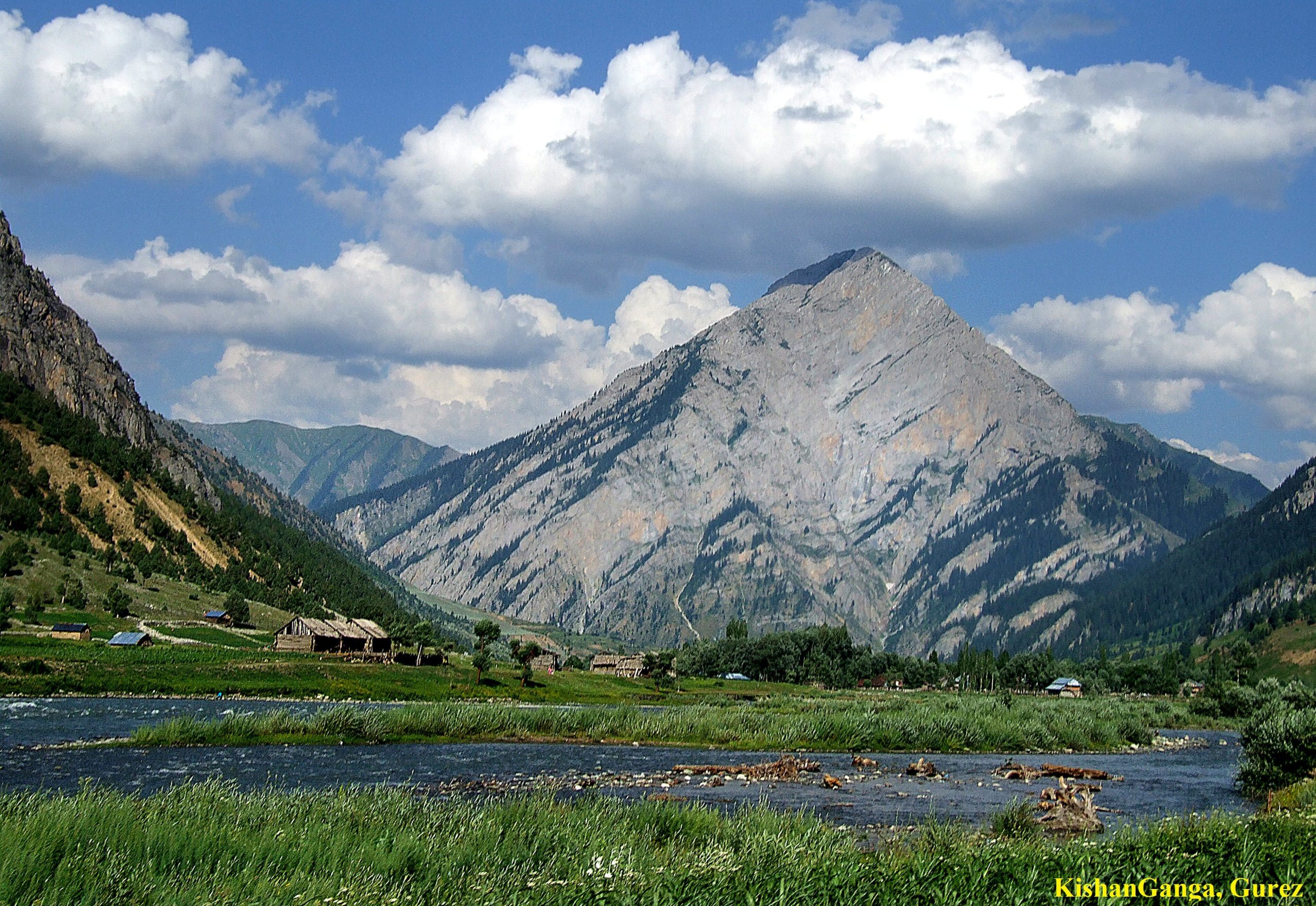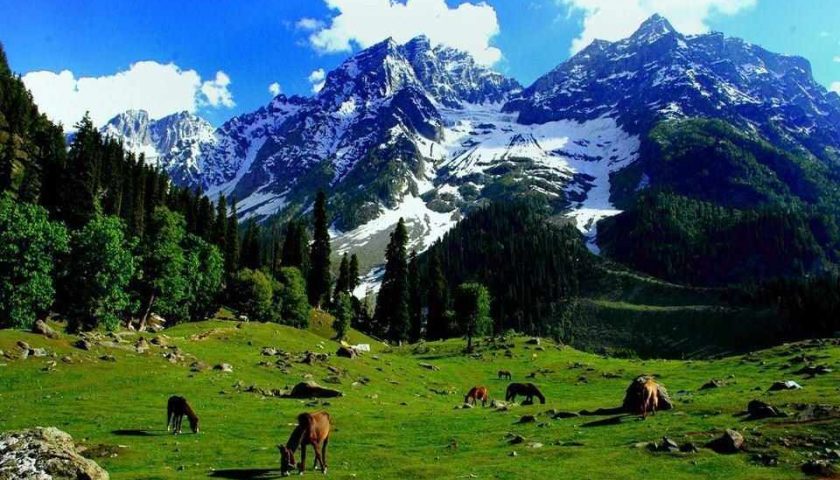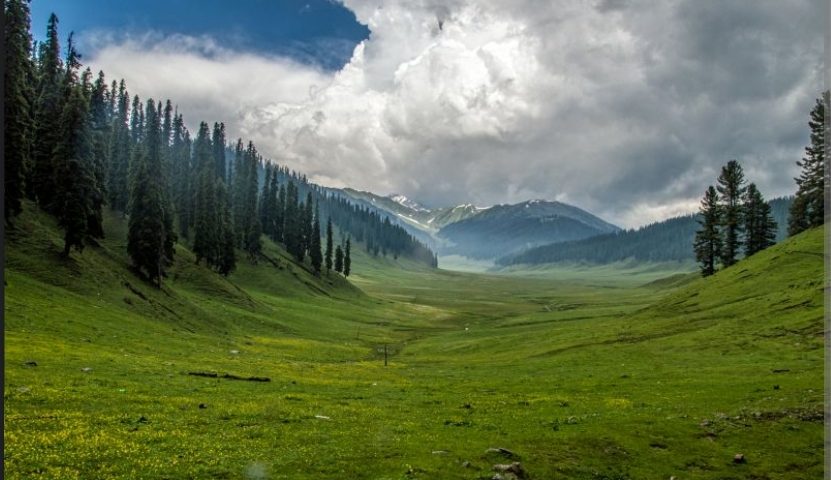As more and more tourists troop in, the remote valley is poised for a cultural and commercial transformation
The evergreen fever dream of Kashmir as the subcontinent’s enchanted Eden might have its antecedents in older travel musings of European raconteurs—often mountaineers, preachers, doctors, and high-ranking officers of the British Empire. These men drew eloquent comparisons between this unheralded wonderland and familiar delights back home. The English rock climber Oscar Eckenstein recalled London’s Hampstead Heath upon seeing a blooming garden in Srinagar, while the adventurer Dermot Norris’ 1932 guide was titled Kashmir: The Switzerland of India.
Eckenstein, who roamed these parts in the 1890s, particularly noted similarities between the Swiss countryside and Gurez, an intimate clasp of small villages in the Kishanganga river valley. “The scenery here exactly resembles the Swiss but is on a larger scale,” he wrote. Gurez was mapped in greater detail by Sir Walter Roper Lawrence, an English civil servant, in his 1895 book, The Valley of Kashmir. He ventured that some day the sweep of its harsh mountain crags, soothing teal streams, and freshly tilled plains might pry visitors away from the more obvious appeals of Kashmir’s other prominent vacation spots.
Also Read | Naranag: Exploring the Rich History, Enchanting Scenery, and Trekking Paradise of Kashmir
“Gulmarg, Sonamarg, and Nágmarg are charming places for a summer holiday,” he wrote. “Perhaps Pahlgám, the village of the shepherds which stands at the head of the Liddar valley with its healthy forest of pines, and Gurais, which lies at a distance of thirty-five miles from Bandipura, the port of the Wular lake, will before long rival in popularity the other Margs.” In the years since, Pahalgam fulfilled the promise of Lawrence’s expectations. Gurez, which adjoins the heavily guarded Line of Control (LoC) bordering Pakistan-occupied Kashmir (PoK) in Kashmir Valley’s north, remained off-limits to travellers until 2007 when restrictions were finally lifted, albeit only for domestic visitors. Each passing season, tourists streamed into Kashmir, steadily increasing in number, but it was not until recently that this swell embraced the self-contained sanctuary of Gurez Valley.
Tourism in Kashmir breached records in 2022, with news reports suggesting that anywhere between 1.62 and 1.88 crore visitors came last year to the Union Territory—the highest number for the UT since Independence. The year 2023 might leave those milestones in the dust, and the Lieutenant Governor of Jammu and Kashmir, Manoj Sinha, has not let an occasion slip by without mentioning this stratospheric spike. At a golf tournament opening in September 2023, he highlighted the G20 event held in Srinagar as the catalyst for a 350 per cent increase in foreign arrivals to Kashmir from 2022. He revealed that as of two months ago (from September), travel footfall had crossed 1.70 crore visitors and that by the end of December that statistic would be close to two crore visitors.
Also Read | Kashmir’s stunning landscapes make It a Top Destination for Weddings
Gurez’s contribution to the overall tourism figures is still smaller than that of other destinations but it is rising; 2022’s estimates were around 50,000, but in 2023, one lakh tourists had visited the region by July. As fistful as these figures seem, when compared with Gurez’s native population (37,992 as per Census 2011), they portend a remarkable commercial and cultural reshaping, teed off originally by the Indian government’s abrogation of Article 370 in 2019. No wonder then that everywhere one goes—corner shops, tea stalls, army check posts—Gurezis respond to the perfunctory questions about how they are doing with head shakes and variations of the same answer: “So many tourists!”
Milk and honey
In September 2023, Bandipora, the main transit hub between Gurez and Srinagar, hosted the “Grand Gurez” festival, a travel and cultural fete aimed at drawing more non-Kashmiris to the region by amplifying not only its meadows and farms but also its scope for outdoor pursuits such as angling, river rafting, mountain biking, trekking, and camping. The event’s top billing was reserved for a polo match, which has not been played here in six decades. That same month, Gurez was showered with more recognition when the Ministry of Tourism chose its main town centre, Dawar, as the best tourism village among 750 entries from all over India. To some, all this spotlighting of Gurez is “too much, too soon”, to others it is delayed wish fulfilment, but its days as a cloaked fairyland where only a lucky few were granted passage are now over.
Gurez endears itself to travellers with remote pastoralism and an inaccessible, unearthly beauty. Like crossing a moat to enter a castle, before one reaches the green vale, there is a six-hour drive from Srinagar to endure. Swerving through dangerous hairpin bends carved out of the grey mountain rock, the Gurez-Bandipora route’s highest elevation arrives at Razdan Pass, an unevenly laid concrete mountain road at 11,672 feet (3,557.6 metres), with steep precipices on either side. From here, every checkpoint (the Border Security Force, the army, and even the local police) scrutinises tourists to Gurez. Occasionally, a chatty officer softens at the idea of faraway visitors about to discover the bounty in his backyard and smilingly waves one onward.
Also Read | Bungus Valley: The Hidden Gem of The Himalayas
Once Gurez Valley approaches, the landscape flips almost diametrically, from granite and dust to milk and honey. Villages here breathe in the glow of the waters from the Kishanganga, foaming furiously through Gurez’s plains, cupped on either side by forested mountain slopes of willow and fir. Along the basin, rice, beans, and millet cultivation flourishes. Walnuts, berries, and a host of rare medicinal plants thrive at higher altitudes. Gurez’s soil bears many riches: cumin, buckwheat, and spices grow widely as do flowers rarely seen in the country’s mainland.
“It is a near-perfect picture of Himalayan idyll, if not for the barbed LoC wire running along the rock face flanking the river, a reminder that temporary silence ought not to be mistaken for lasting peace.”
In the distance, Habba Khatoon Peak, 13,000 feet of snow-flecked limestone magnificence, casts a shadow over all the eye can see. It is a near-perfect picture of Himalayan idyll, if not for the barbed LoC wire running along the rock face flanking the river, a reminder that temporary silence ought not to be mistaken for lasting peace. In conversations, villagers will raise their finger in the direction of the mountain wire, saying: “See, on the other side of that is Pakistan. Everything is quite normal.”
Also Read | Experience the Enchantment of Gurez Valley: Go Gurez, Kashmir’s Hidden Gem!
For border communities in Kashmir, geopolitics is a simmering wound that can flare up without warning. Gurezis seem to have grown accustomed, overwhelmingly, to their position on the LoC and the presence of armed forces, posted in their villages for years. “We need their help in the winter months,” one shopkeeper says, referring to the helicopter service that shuttles villagers to Bandipora once the road to Gurez is snowed in. Another tourist guide remarks that visitors tend to make more of the dispute with our neighbours than they do. “This conflict [with Pakistan] serves a few vested interests in both countries, but we are fed up with it.”
Lack of basic amenities
Before the hordes arrived, mountain trekkers were foremost to discover Gurez’s heavenly escape. Even today, they are some of the most conspicuous visitors to the valley, usually camping here to and from short expeditions. Dawar, the valley’s central town, with a busy thoroughfare and a market, advertises plentiful hotels and lodging options, including tents by the riverside. Kaka Palace, the oldest guest house here, is a landmark known to many. Inside the guest house’s crammed restaurant, trekkers, with fatigued eyes and slouching backpacks, clamour for lunch orders: hearty chicken curries, dal-rice, rajma, with slurps of steaming kahwa on the side. Here and there, one spots family vacationers now. A Bengali couple at breakfast explains their Gurez trip. “We both work in different cities, so we end up spending time with each other only when we travel. We chose Kashmir this time and came to Gurez because it is so far from all the rush,” said the wife.
Also Read | Unveiling Kashmir: A Beginner’s Guide to Traveling and Discovering its Historic Monuments
Kaka Palace does not offer much by way of creature comforts, mere hostel-style accommodations with hot water. The burgeoning throng of tourists headed to the valley in the next few years is bound to demand more. Across the gate from the lodge, construction is on in full swing on a ritzier building, also belonging to the Kaka Palace owner, who plans to inaugurate it in May 2024. “This might be Gurez’s first five-star hotel,” whispers one local driver with a prideful glint in his eye. Zipping through Dawar as he ferries tourists on their day trips, he rattles off names of a few other boutique hotels that have mushroomed in Gurez, adding that business here may have outgrown the guest house model. Outside a brightly lit pine-log café, he halts his car to emphasise the sign, “Log Out Cafe! Gurez’s first coffee shop.”
Beyond mocha lattes and cappuccinos, villagers hope for more substantial changes from tourism. Some have upgraded from wooden homes to concrete structures and day-long indoor heating to alleviate harsh winters. But it remains a challenge, given that the entire region still receives electricity only for a few hours in the evening. This, despite its proximity to the Kishanganga Hydroelectric Project, which supplies power to Bandipora and neighbouring areas. In a 2018 column, the Kashmiri bureaucrat Wajahat Habibullah lamented Gurez’s lack of basic amenities since Independence. “The 330 MW 3 unit [Kishanganga] project will generate 1,713 million units of electricity annually. Of this, the citizens of Gurez will get not a sliver,” he wrote, adding elsewhere: “There is no electricity, no piped water, no drainage, no public sanitation, no tarred road and no hospital.”
Also Read | Love in the Air: Discovering the Most Romantic Places to Visit in the Kashmir Valley
“There are swathes of Gurez unbothered by practicalities, or perhaps spiritually at odds with the quotidian. Even someone not born of this land would not care to change a leaf here.”
Among a group of tourism students from Kashmir University, enjoying their evening tea at the popular viewpoint Khandyal Lotuh, the discussions are less heated but nevertheless lively. While debating the merits of Gurez as a destination, one of them said: “We are here to prepare a report for our class on what facilities in Gurez can improve the experience for travellers and citizens alike.” Another student discusses how they could make travel to these parts “more sustainable”. Years of negligence have isolated Gurez, but in the earnest optimism of these students, commercial tourism and its lightning pace will send the valley hurtling towards the future it deserves.
From another world
There are swathes of Gurez unbothered by practicalities, or perhaps spiritually at odds with the quotidian. Even someone not born of this land would not care to change a leaf here. At the base of Habba Khatoon—the peak named after a mystic poet who in some of the legends wrote pining songs for her lost lover, the former ruler of Kashmir—a cool stream gushes along gently next to the village of Achoora. Local people believe this water to possess healing qualities. An old woman, in her wooden cloak and khoi (a woollen skullcap worn by locals), lugs an oversized bundle of firewood on her back, hunched over like a hook to carry its weight. Watching her trod along quietly, one can strike out the thought of ever complaining about heavy backpacks again.
The edge of Tulail Valley, a sub-tehsil of Gurez established in 2014, is one of the region’s most romantically bucolic. In Anaikot, another tiny hamlet, women, young and old, carry firewood across shaky bridge planks and stack up logs to build their ancient wooden cabins on stilts, conjuring a time when all that existed were these mountains and these people. Gurez’s original settlers are Dards, tribes from Dardistan, who speak a language called Shina. In antiquity, Dardistan encompassed some of the uppermost mountain reaches of India and Pakistan. After Partition, Dards have largely been consigned to Gurez, struggling to preserve their heritage even as their surroundings are rapidly modernised.
Also Listen | Kya Karie Korimol With Kashur Wanvun – CokeStudio
Back at Khandyal Point, one observes a slew of makeshift tents, the kind often built by nomads and shepherds consisting of elegant cloth triangles with a single central pole. “The Bakarwals have arrived,” cries out a tourist guide who sees them. Inside the tents, women dressed in traditional salwar-kameez with dupattas covering their heads sit playing with children on their laps. A child gravitates to a tourist’s iPhone, posing for pictures playfully. The tourist requests one of the women to pose too, which she relents to after some persuasion.
Also Read | From kulcha to quinoa: How India’s evolving foodscape signals other social revolutions
The Bakarwals, chronicled obsessively by travellers around the world, have been a subject of eternal fascination. Rural nomads for life, they are resolutely of another world, moving through the mountains and pastures with their sheep or goat herds, collecting wildflowers and herbs along the way in large cloth bundles. Come summer, they slowly climb their way up to Gurez from Rajouri and Poonch, heading back to the lowlands once snowfall resumes.
A Gurez where resorts, ski rinks, and golf courses edge out its maverick indigenous peoples might lose what made it special in the first place. Decades ago, Joni Mitchell had warned about paving paradise to put up parking lots, and Gurez seems perched on the cusp of a similar upheaval. The world outside might do well to go gentle on this beautiful valley. Perhaps that is the glorious bargain of any travel, especially to a place of unfathomable hidden nooks and secrets. The more one sees it, the less one touches the hem of its garment. Source
Also Read | Kashmir as a Honeymoon Destination: Top reasons why to choose?






